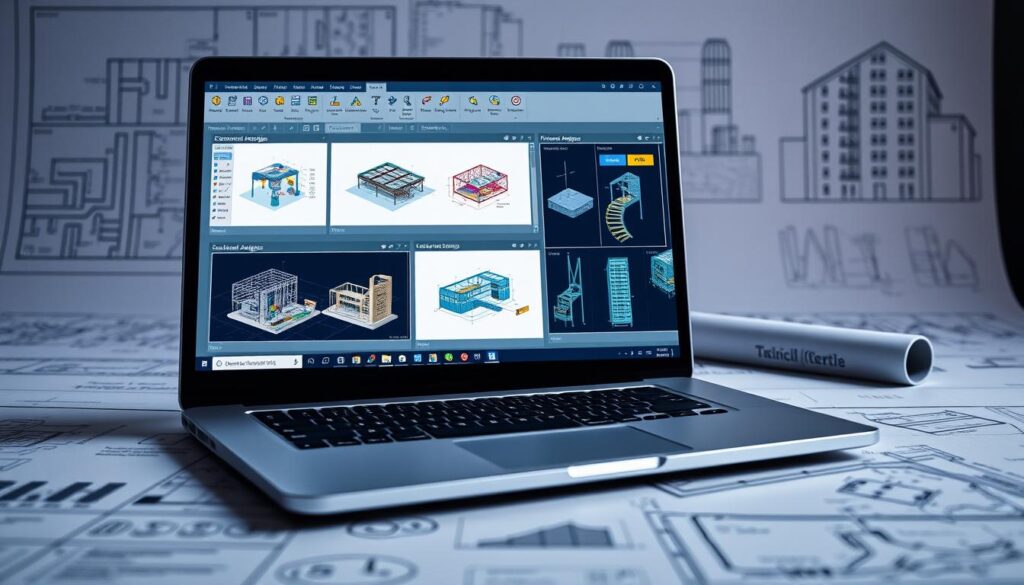The civil engineering industry is undergoing a significant revolution, with digital transformation playing a crucial role in shaping its future.
A recent study revealed that the adoption of simulation tools and modern design software has improved project efficiency by up to 30%. This statistic highlights the impact of technology on the industry.
As the industry continues to evolve, it’s essential to understand the benefits and applications of these technologies. This article will explore the role of simulation tools and modern design software in civil engineering projects.
Key Takeaways
- The use of simulation tools improves project efficiency.
- Modern design software enhances collaboration among teams.
- Digital transformation is driving innovation in civil engineering.
- The adoption of new technologies reduces project costs.
- Simulation tools and modern design software are becoming essential in the industry.
The Importance of Digital Transformation in Civil Engineering
Digital transformation is revolutionizing the civil engineering sector by introducing cutting-edge technologies that enhance project efficiency and collaboration. This transformation is not just about adopting new tools but also about changing the way projects are managed and executed.
Understanding Digital Transformation
Digital transformation in civil engineering involves the integration of digital technology into all areas of the business, fundamentally changing how companies operate and deliver value to their clients. It encompasses a wide range of technologies, including simulation tools, modern design software, and data analytics.
Key components of digital transformation include:
- Advanced simulation and modeling tools
- Building Information Modeling (BIM)
- Data-driven decision making
- Collaboration platforms
Benefits for Civil Engineering Projects
The adoption of digital transformation in civil engineering projects offers numerous benefits, including enhanced collaboration, improved project efficiency, and reduced costs. By leveraging digital technologies, civil engineers can:
| Benefit | Description | Impact |
|---|---|---|
| Enhanced Collaboration | Digital platforms facilitate real-time communication among stakeholders. | Improved project coordination and reduced misunderstandings. |
| Improved Efficiency | Automation and streamlined processes reduce manual labor. | Faster project completion and reduced labor costs. |
| Cost Reduction | Accurate simulations and modeling reduce the need for physical prototypes. | Lower costs associated with design iterations and material waste. |
By embracing digital transformation, civil engineering firms can not only improve their current operations but also position themselves for future success in a rapidly evolving industry.
Overview of Simulation Tools in Civil Engineering

Simulation tools play a crucial role in modern civil engineering, enabling professionals to simulate real-world conditions and make informed decisions. These tools have become essential for designing, analyzing, and optimizing infrastructure projects.
Types of Simulation Tools
Civil engineering utilizes a variety of simulation tools, including BIM (Building Information Modeling) and CAD (Computer-Aided Design) software. These tools help in creating detailed models and simulations of projects, allowing for better planning and execution.
Some of the key simulation tools used in civil engineering are listed in the following table:
| Tool | Description | Application |
|---|---|---|
| Autodesk Civil 3D | A design and documentation solution for civil engineering projects. | Road design, site development, and land planning. |
| Bentley Systems MicroStation | A CAD software used for 2D and 3D modeling. | Infrastructure design, including roads, bridges, and buildings. |
| ANSYS Civil | A simulation tool for analyzing the structural integrity of designs. | Structural analysis and simulation. |
For more information on the best civil engineering design software, visit G2’s guide on civil engineering design.
Applications in Project Workflow
Simulation tools are applied at various stages of civil engineering projects, from initial design to final construction. They help in optimizing designs, reducing material costs, and improving project timelines.
For instance, using AutoCAD for civil engineering projects can significantly enhance the design process by allowing for precise drafting and modeling.
Key Features of Modern Design Software
Modern design software is at the forefront of innovation in civil engineering, offering a range of features that enhance design accuracy and collaboration. These software solutions have become indispensable tools for civil engineers, enabling them to design, analyze, and simulate projects with greater precision and efficiency.
User-Friendly Interfaces
One of the standout features of modern design software is its user-friendly interface. These intuitive interfaces make it easier for engineers to navigate the software, reducing the learning curve and increasing productivity. Features like drag-and-drop functionality, customizable toolbars, and clear visualization tools enable engineers to focus on the design rather than struggling with the software.
Integration with Other Tools
Another critical feature of modern design software is its ability to integrate with other tools and systems. This integration facilitates a seamless workflow, allowing data to be shared across different platforms and teams. For instance, integration with project management tools enables engineers to track project progress in real-time, while integration with analysis software allows for more accurate simulations.
| Feature | Description | Benefit |
|---|---|---|
| User-Friendly Interface | Intuitive design and navigation | Increased Productivity |
| Integration Capabilities | Seamless data sharing across platforms | Enhanced Collaboration |
| Advanced Simulation Tools | Accurate project simulations | Improved Design Accuracy |
By incorporating these key features, modern design software is revolutionizing the civil engineering industry. As technology continues to evolve, we can expect these software solutions to become even more sophisticated, further enhancing the design process and project outcomes.
Enhancing Project Efficiency with Simulation Tools

Simulation tools are revolutionizing the civil engineering landscape by significantly enhancing project efficiency. These tools enable engineers to create detailed digital models that simulate real-world conditions, allowing for more accurate planning and execution.
Streamlining Design Processes
One of the primary benefits of simulation tools is their ability to streamline design processes. By using advanced software solutions, engineers can simulate various design scenarios, test hypotheses, and identify the most effective solutions without the need for physical prototypes. This not only saves time but also reduces costs associated with trial and error methods.
For instance, digital twin technology is becoming increasingly popular in civil engineering. It involves creating a virtual replica of a physical project, allowing for real-time monitoring and simulation. This technology is a prime example of digital innovation in construction, enhancing project efficiency by enabling predictive maintenance and reducing downtime.
Reducing Errors and Rework
Simulation tools also play a crucial role in reducing errors and rework in civil engineering projects. By simulating different scenarios, engineers can identify potential issues early in the design phase, thereby minimizing the risk of costly rework later on. This proactive approach to project management is a hallmark of software solutions in civil engineering, where accuracy and precision are paramount.
Moreover, simulation tools facilitate better collaboration among project stakeholders. By providing a shared platform for data analysis and visualization, these tools ensure that all parties are on the same page, further reducing the likelihood of errors and miscommunication.
In conclusion, simulation tools are indispensable in modern civil engineering, enhancing project efficiency by streamlining design processes and reducing errors and rework. As the industry continues to embrace digital innovation in construction, the role of these tools will only continue to grow.
The Role of Building Information Modeling (BIM)
Building Information Modeling (BIM) is revolutionizing the civil engineering landscape by providing a comprehensive digital representation of a project’s physical and functional characteristics. This technology is not just a tool, but a process that involves creating and managing digital models throughout a project’s lifecycle.
What is BIM?
BIM is more than just a 3D modeling software; it’s an intelligent model-based process that allows civil engineers to plan, design, construct, and manage buildings and infrastructure projects more efficiently. By incorporating detailed information about the project’s components, BIM facilitates better decision-making and collaboration among stakeholders.
The use of BIM in civil engineering involves creating a digital twin of the project, which can be used to simulate various scenarios, analyze performance, and predict potential issues. This enables engineers to optimize the design, reduce errors, and improve overall project outcomes.
Advantages of Using BIM in Design
The adoption of BIM in civil engineering offers numerous benefits, including improved collaboration, enhanced data accuracy, and increased project efficiency. By using BIM, engineers can create detailed models that include information about the project’s geometry, spatial relationships, and other relevant data.
One of the significant advantages of BIM is its ability to facilitate collaboration among different stakeholders. By providing a shared platform for data management, BIM enables architects, engineers, contractors, and owners to work together more effectively. For more information on the advantages of BIM, visit this resource.
The use of BIM also supports sustainable design practices by allowing engineers to analyze the environmental impact of their designs. By simulating different scenarios and evaluating the results, engineers can optimize their designs to minimize environmental footprint and improve sustainability.
How Analysis Software Improves Structural Integrity

The use of advanced analysis software is revolutionizing the field of civil engineering by improving structural integrity. This software enables engineers to simulate various conditions and loads on structures, identifying potential weaknesses before they become critical issues.
Structural Analysis Tools Overview
Structural analysis tools are a crucial component of civil engineering software. These tools allow engineers to model and analyze the behavior of structures under different conditions, such as stress, strain, and various external loads. By using these tools, engineers can predict how a structure will perform and make necessary adjustments to enhance its integrity.
Some of the key features of structural analysis tools include:
- Linear and nonlinear analysis capabilities
- Dynamic analysis for seismic and wind loads
- Material modeling for various construction materials
Safety and Compliance in Design
Ensuring safety and compliance is paramount in civil engineering design. Analysis software helps engineers adhere to relevant codes and standards by simulating the behavior of structures under various conditions. This not only enhances the safety of the structure but also ensures compliance with regulatory requirements.
By leveraging simulation tools and software solutions in civil engineering, engineers can:
- Identify potential design flaws early in the process
- Optimize structural performance
- Reduce the risk of costly rework or failures
The integration of analysis software into the design process is a significant step forward in improving structural integrity. As civil engineering software continues to evolve, we can expect even more sophisticated tools to emerge, further enhancing the field.
Virtual Reality (VR) and Augmented Reality (AR) in Design
The integration of Virtual Reality (VR) and Augmented Reality (AR) in civil engineering is revolutionizing the design process. These technologies are not just enhancing the way designs are created and visualized but are also improving stakeholder engagement and project outcomes.
Immersive Design Experiences
VR and AR provide immersive design experiences that allow engineers and stakeholders to interact with designs in a more engaging and intuitive way. By visualizing projects in a virtual environment, teams can identify potential issues earlier, explore design alternatives, and make more informed decisions.
For instance, using VR, engineers can conduct virtual walkthroughs of a project, gaining insights into the spatial relationships and aesthetics of the design. This can be particularly valuable in complex infrastructure projects where understanding the interplay between different components is crucial.
Enhancing Stakeholder Engagement
One of the significant benefits of VR and AR in civil engineering design is their ability to enhance stakeholder engagement. By providing a more immersive and interactive experience, stakeholders can better understand the design intent and offer more meaningful feedback.
According to a report on the future of architecture and engineering, the use of VR and AR is becoming increasingly prevalent as a tool for improving communication and collaboration among project stakeholders. For more insights, you can read about how VR and AR are being adopted in the industry here.
By leveraging VR and AR, civil engineers can create more effective designs, improve project outcomes, and drive digital innovation in construction. As these technologies continue to evolve, their impact on the civil engineering industry is expected to grow, enabling more efficient, sustainable, and innovative design practices.
Real-Time Data Analytics in Civil Engineering

Real-time data analytics is becoming a crucial tool in civil engineering for informed decision-making. The ability to analyze data as it is collected allows for more accurate predictions, better project management, and enhanced collaboration among stakeholders.
Data-Driven Decision Making
The importance of data-driven decision-making cannot be overstated in civil engineering. By leveraging real-time data, engineers can make more informed decisions, reducing the risk of errors and improving project outcomes. Digital transformation in construction is significantly driven by the adoption of real-time data analytics, enabling projects to be executed more efficiently.
Benefits of Data-Driven Decision Making:
- Improved project planning and management
- Enhanced collaboration among stakeholders
- Reduced risk through predictive analytics
- Better resource allocation
Tools for Real-Time Analytics
Several tools are available for real-time data analytics in civil engineering, ranging from specialized software solutions to integrated platforms that offer comprehensive project management capabilities. These tools enable the collection, analysis, and visualization of data in real-time, facilitating swift and informed decision-making.
| Tool | Description | Key Features |
|---|---|---|
| Dashboard Software | Provides real-time insights into project performance | Customizable dashboards, real-time data visualization |
| IoT Sensors | Collects real-time data from the project site | Real-time monitoring, automated data collection |
| Project Management Platforms | Integrates data analytics with project management | Task management, resource allocation, real-time reporting |
The adoption of these tools is part of the broader digital transformation in civil engineering, which is reshaping how projects are planned, executed, and managed. By embracing real-time data analytics, civil engineers can significantly improve project outcomes and contribute to the advancement of the field.
Collaborative Design Platforms
Digital innovation in construction is being driven by collaborative design platforms that facilitate seamless team collaboration. These platforms are transforming the way civil engineers work together on projects, enabling real-time collaboration and improving project outcomes.
Facilitating Team Collaboration
Collaborative design platforms provide a centralized workspace where team members can share information, track changes, and collaborate on designs. This leads to improved communication among team members and reduces the likelihood of misunderstandings. By using these platforms, civil engineers can work more efficiently, ensuring that projects are completed on time and within budget.
Key benefits of collaborative design platforms include:
- Enhanced team collaboration
- Improved communication
- Real-time tracking of changes
- Reduced errors and rework
Sharing Insights Across Disciplines
These platforms also enable the sharing of insights across different disciplines, fostering a more integrated approach to project design. By bringing together data from various stakeholders, collaborative design platforms help civil engineers make more informed decisions. This interdisciplinary collaboration is crucial for complex civil engineering projects, where multiple factors need to be considered.
The use of collaborative design platforms represents a significant step forward in the adoption of modern design software in civil engineering.
| Feature | Description | Benefit |
|---|---|---|
| Real-time Collaboration | Multiple users can work on a project simultaneously | Improved project efficiency |
| Version Control | Changes are tracked and recorded | Reduced errors |
| Data Sharing | Information is shared across disciplines | Informed decision-making |
By leveraging collaborative design platforms, civil engineers can enhance their workflow, improve project outcomes, and drive digital innovation in construction.
The Impact of Cloud Computing on Civil Engineering

Cloud computing is transforming the civil engineering landscape by providing scalable, flexible, and efficient solutions for complex projects. This technological shift is enabling civil engineers to collaborate more effectively, manage large datasets, and streamline project workflows.
The benefits of adopting cloud-based solutions in civil engineering are multifaceted. Firstly, cloud computing enhances collaboration among project stakeholders by providing a centralized platform for data sharing and project management. This leads to improved communication and reduced errors. Secondly, cloud-based solutions offer scalability, allowing projects to easily scale up or down according to their needs without significant upfront investments in hardware. Lastly, cloud computing improves data management by providing robust storage and processing capabilities for large datasets.
Advantages of Cloud-Based Infrastructure
Cloud-based infrastructure provides several advantages for civil engineering projects, including:
- Enhanced collaboration through real-time data sharing and project management tools.
- Scalability to adapt to changing project requirements.
- Cost-effectiveness by reducing the need for on-premise hardware and maintenance.
- Improved data security through advanced security measures and backups.
For more insights on how technology is transforming civil engineering, visit this article on AI in civil.
Successful Implementations of Cloud Computing
Several civil engineering projects have successfully implemented cloud computing to improve their operations. For instance, a leading construction company adopted a cloud-based project management platform to streamline its workflow, resulting in a 30% reduction in project timelines. Another example is a civil engineering firm that used cloud-based structural analysis software to collaborate with international teams, enhancing their design capabilities and reducing errors.
These case studies demonstrate the potential of cloud computing to transform civil engineering practices by improving collaboration, scalability, and data management. As the industry continues to evolve, the adoption of cloud-based solutions is expected to play a crucial role in shaping the future of civil engineering.
Simulation Tools for Environmental Impact Assessment
With the advent of advanced simulation tools, environmental impact assessments in civil engineering have become more accurate and efficient. These tools enable engineers to model various environmental scenarios, predicting the potential impacts of their projects.
Assessing Sustainability with Simulation
Sustainability assessment is a critical component of modern civil engineering projects. Simulation tools allow engineers to evaluate different design options and their environmental implications, facilitating the selection of the most sustainable solutions.
By utilizing civil engineering software, professionals can analyze factors such as energy consumption, water usage, and waste generation, ensuring that their projects meet stringent environmental standards.
Tools for Environmental Modeling
Various simulation tools are available for environmental modeling, each with its unique capabilities. Some of the most commonly used tools include:
- Software for hydrological modeling
- Tools for air quality assessment
- Programs for noise pollution analysis
These tools not only aid in assessing environmental impact but also contribute to digital innovation in construction by streamlining the design process and improving collaboration among stakeholders.
By leveraging these advanced tools, civil engineers can ensure that their projects are not only structurally sound but also environmentally sustainable.
The Future of Civil Engineering Software

The civil engineering sector is on the cusp of a technological revolution, driven by advancements in software technology. As we look ahead, it’s clear that the industry will be shaped by emerging technologies that promise to enhance efficiency, sustainability, and innovation.
Emerging Technologies to Watch
Several key technologies are poised to make a significant impact on civil engineering. Artificial Intelligence (AI) and Machine Learning (ML) are being integrated into design and analysis software, enabling more sophisticated and data-driven decision-making processes.
Another area of development is the use of Internet of Things (IoT) devices for real-time monitoring of infrastructure, allowing for predictive maintenance and improved safety.
Predictions for the Next Decade
Over the next decade, we can expect to see a significant shift towards more collaborative and integrated design platforms. Cloud-based solutions will become more prevalent, facilitating greater teamwork and data sharing across disciplines.
The adoption of Virtual Reality (VR) and Augmented Reality (AR) technologies will also continue to grow, providing immersive design experiences that enhance stakeholder engagement and project visualization.
As these technologies mature, they will drive the digital transformation in civil engineering, leading to more efficient, sustainable, and resilient infrastructure projects.
Challenges in Digital Transformation
Digital transformation in civil engineering is not without its hurdles. As the industry continues to adopt new technologies, several challenges come to the forefront, impacting the successful implementation of digital tools.
Resistance to Change in Organizations
One of the primary challenges is resistance to change within organizations. Employees may be accustomed to traditional methods and may be hesitant to adopt new software solutions or workflows. This resistance can stem from a lack of understanding of the benefits of digital transformation or fear of job displacement due to automation.
To overcome this, organizations must invest in change management strategies, including comprehensive training programs and clear communication about the benefits of digital transformation. For instance, a study highlighted in a recent article on digital transformation in various engineering fields emphasizes the importance of organizational buy-in and training.
Addressing Skill Gaps in the Workforce
Another significant challenge is addressing the skill gaps in the workforce. As civil engineering technology advances, the demand for professionals with expertise in software solutions and data analysis increases. Existing employees may need training to adapt to new tools, while new hires may be required to possess skills that were not previously necessary.
To address this, companies can implement continuous learning programs, providing employees with opportunities to develop new skills. This not only enhances the workforce’s capabilities but also boosts morale and retention. By focusing on upskilling and reskilling, civil engineering firms can ensure they have the talent needed to leverage digital transformation effectively.
In conclusion, while digital transformation presents several challenges, including resistance to change and skill gaps, these can be addressed through strategic planning, training, and a commitment to embracing new technologies.
Case Studies of Successful Digital Transformation

Through the lens of successful case studies, we can understand how digital transformation is revolutionizing the civil engineering landscape. By embracing digital innovation in construction, companies are achieving unprecedented levels of efficiency and precision.
Highlighting Specific Projects
Several high-profile projects have demonstrated the potential of civil engineering software and modern design software. For instance, the use of Building Information Modeling (BIM) has streamlined the design process, reducing errors and improving collaboration among stakeholders. A notable example is the digital transformation in engineering projects that have successfully integrated BIM and other digital tools.
The implementation of simulation tools has also been a critical factor in the success of these projects. By allowing engineers to model and analyze complex systems, these tools have enabled the development of more sustainable and resilient infrastructure.
Lessons Learned from Industry Leaders
Industry leaders have shared valuable insights into the challenges and opportunities presented by digital transformation. One key lesson is the importance of investing in training and development to ensure that the workforce has the necessary skills to effectively utilize new technologies.
Another crucial factor is the need for a cultural shift within organizations, embracing a more collaborative and innovative approach to project delivery. This involves leveraging essential software for civil engineers to facilitate communication and data sharing across disciplines.
| Project | Digital Tools Used | Outcomes |
|---|---|---|
| Bridge Construction | BIM, Simulation Tools | Reduced construction time by 20%, Improved structural integrity |
| Highway Development | Modern Design Software, Real-Time Data Analytics | Enhanced project efficiency, Reduced costs by 15% |
| Building Renovation | Virtual Reality (VR), Collaborative Design Platforms | Improved stakeholder engagement, Reduced rework by 10% |
By examining these case studies and lessons learned, it becomes clear that digital transformation is not just a trend, but a necessity for the future of civil engineering. As the industry continues to evolve, the adoption of digital innovation in construction will play a pivotal role in shaping the built environment.
Training and Development for Civil Engineers
The rapidly changing landscape of civil engineering necessitates a commitment to continuous learning and skill development. As technology advances, civil engineers must stay updated on the latest tools and methodologies to remain competitive and deliver high-quality projects.
Importance of Continuous Learning
Continuous learning is crucial in civil engineering due to the rapid evolution of technologies such as BIM (Building Information Modeling), AutoCAD Civil 3D, and other simulation tools. These technologies enhance project efficiency, accuracy, and innovation. For instance, proficiency in AutoCAD Civil 3D certification can significantly boost a civil engineer’s capability to design and manage complex infrastructure projects.
According to a recent industry report, “The future of civil engineering is deeply intertwined with digital transformation, making ongoing education and training not just beneficial, but essential.”
“The future of civil engineering is deeply intertwined with digital transformation, making ongoing education and training not just beneficial, but essential.” – Industry Report
Available Courses and Workshops
Several institutions and online platforms offer courses and workshops tailored to the needs of civil engineers. These include:
- Certification programs in AutoCAD Civil 3D and other design software
- Workshops on the latest BIM technologies and their applications
- Training sessions on simulation tools for environmental impact assessment
- Seminars on digital transformation and its implications for civil engineering
These educational opportunities enable civil engineers to upskill and reskill, ensuring they remain relevant in a rapidly changing industry.
| Course/Workshop | Description | Duration |
|---|---|---|
| AutoCAD Civil 3D Certification | Comprehensive training on AutoCAD Civil 3D software | 4 weeks |
| BIM Technology Workshop | Hands-on experience with the latest BIM tools | 2 days |
| Environmental Impact Assessment | Training on simulation tools for environmental assessment | 3 weeks |
In conclusion, the commitment to training and development is vital for civil engineers to navigate the challenges and opportunities presented by digital transformation. By embracing continuous learning, professionals can enhance their skills, improve project outcomes, and contribute to the advancement of the field.
Conclusion: Embracing the Future of Civil Engineering
The civil engineering industry is on the cusp of a revolution, driven by digital transformation. As discussed, simulation tools, modern design software, and civil engineering technology are transforming the way projects are designed, executed, and managed.
Key Takeaways
Digital transformation in civil engineering brings numerous benefits, including enhanced project efficiency, reduced errors, and improved structural integrity. Building Information Modeling (BIM), analysis software, and collaborative design platforms are some of the key technologies driving this change.
Adopting Digital Tools
To stay competitive, civil engineers must adopt these digital tools. By leveraging modern design software and civil engineering technology, professionals can improve project outcomes, drive innovation, and meet the evolving demands of the industry. Embracing digital transformation is no longer a choice but a necessity for the future of civil engineering.
